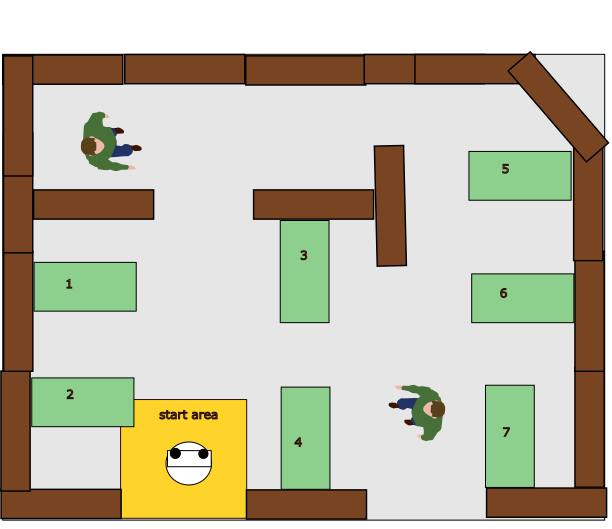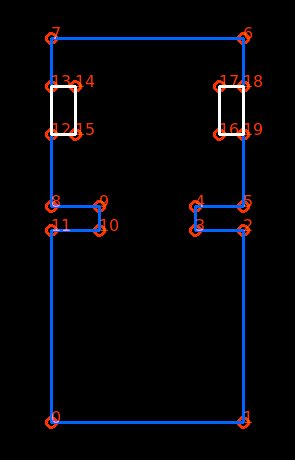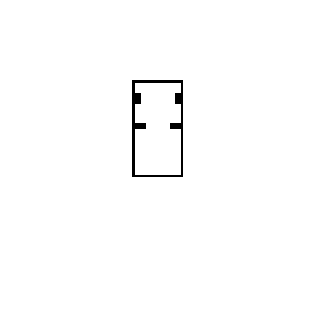Embedded Motion Control/Restaurant Competition 2024: Difference between revisions
copy 2023 version Tag: 2017 source edit |
No edit summary |
||
| (4 intermediate revisions by the same user not shown) | |||
| Line 3: | Line 3: | ||
'''Challenge Description''' | '''Challenge Description''' | ||
The figure on the right shows a 2D representation of a '''possible''' Restaurant setup, '''as an example'''. The objective is for | The figure on the right shows a 2D representation of a '''possible''' Restaurant setup, '''as an example'''. The objective is for Hero to "deliver" orders from the kitchen to a few tables. Which tables must be reached and in what order will be defined by the judges just before the challenge starts. The restaurant will contain a number of unknown static and dynamic objects (boxes, human actors walking) | ||
The delivery of an order is defined as follows | The delivery of an order is defined as follows | ||
| Line 9: | Line 9: | ||
*Drive up to the table. | *Drive up to the table. | ||
*Position near the table, facing towards the table. The robot should be close enough for a customer to comfortably take their order from the tray. The exact part of the table that the robot stands next to does not matter. | *Position near the table, facing towards the table. The robot should be close enough for a customer to comfortably take their order from the tray. The exact part of the table that the robot stands next to does not matter. | ||
*Give a clear sound signal, signalling | *Give a clear sound signal, signalling Hero has arrived at table A (io.speak("I arrived at table four")). | ||
*Repeat until all the tables are visited in the correct order (your robot does not need to return to the starting point) | *Repeat until all the tables are visited in the correct order (your robot does not need to return to the starting point) | ||
| Line 20: | Line 20: | ||
*There may be multiple routes to a given goal. | *There may be multiple routes to a given goal. | ||
*A number of ''dynamic objects'' will be present in the form of human actors. Additionally, a number of ''static objects'' will be placed throughout the restaurant (including possible chairs next to the tables!). The position does not have to be parallel to the walls. | *A number of ''dynamic objects'' will be present in the form of human actors. Additionally, a number of ''static objects'' will be placed throughout the restaurant (including possible chairs next to the tables!). The position does not have to be parallel to the walls. | ||
**Chairs | **Chairs will '''Not''' show up as squares in your LiDAR measurements. You will only see the legs! | ||
**These extra objects will '''not''' be present on the map that you're provided ahead of time. | **These extra objects will '''not''' be present on the map that you're provided ahead of time. | ||
'''Challenge Conditions''' | '''Challenge Conditions''' | ||
* | *Hero will start in the ''start area'', defined by a rectangle of approximately 1 by 1 meters. The orientation of Hero is arbitrary (i.e., not known to your software). | ||
*The list of tables to be visited will be provided right before the challenge starts as a list of integers (0 identifies the first table in the array). | *The list of tables to be visited will be provided right before the challenge starts as a list of integers (0 identifies the first table in the array). | ||
*After starting the software, | *After starting the software, Hero has to drive to the first table to deliver the order. | ||
*If | *If Hero found the correct ''table'' and signalled his arrival, he has to drive to the next tables to deliver the orders. | ||
*The task is completed after | *The task is completed after Hero visited all tables on the list. | ||
*Within the restaurant start area, we will make sure that some visible features (i.e. lines, corners) remain visible. | *Within the restaurant start area, we will make sure that some visible features (i.e. lines, corners) remain visible. | ||
*An actual map of the restaurant will be provided to the teams one week before the final challenge | *An actual map of the restaurant will be provided to the teams one week before the final challenge (an example is provided at the bottom of this section). | ||
| Line 39: | Line 37: | ||
*The list of tables to visit has to be supplied to the executable when starting the challenge, in the following format (for tables in the order: 2 -> 4 -> 3): | *The list of tables to visit has to be supplied to the executable when starting the challenge, in the following format (for tables in the order: 2 -> 4 -> 3): | ||
<pre>./ | <pre>./hero_do_your_thing 2 4 3 </pre> | ||
*Do not touch the walls or objects! Slightly touching is allowed, however, bumping (''i.e.'', driving head-on into a wall) '''is not allowed'''! If | *Do not touch the walls or objects! Slightly touching is allowed, however, bumping (''i.e.'', driving head-on into a wall) '''is not allowed'''! If Hero hits the wall, '''we''' decide whether it counts as ''bumping''. | ||
*Every team has two trials (= max one restart). A trial ends if: | *Every team has two trials (= max one restart). A trial ends if: | ||
** | **Hero ''bumps'' into: the wall, a static or a dynamic object. | ||
** | **Hero has not moved or has not made sensible movements (as judged by the tutors) for 30 seconds | ||
**The total time limit of 10 minutes per group is reached | **The total time limit of 10 minutes per group is reached | ||
**The group requests a restart (on the first trial) | **The group requests a restart (on the first trial) | ||
*restart means: | *restart means: | ||
** | **Hero restarts at the defined start position | ||
**The trail time (= the time graded) is reset, but | **The trail time (= the time graded) is reset, but | ||
**the total time keeps running | **the total time keeps running | ||
*There will be no second attempt if first attempt was successful | *There will be no second attempt if first attempt was successful | ||
*Every situation that might occur, that is not covered in this document will be evaluated on the spot. If this happens, the judges have the final word. | *Every situation that might occur, that is not covered in this document will be evaluated on the spot. If this happens, the judges have the final word. | ||
| Line 66: | Line 63: | ||
**This way, teams starting the challenge have as much time as teams that do the challenge at the end, compiling in between trials is not allowed. | **This way, teams starting the challenge have as much time as teams that do the challenge at the end, compiling in between trials is not allowed. | ||
'''Interview''' | |||
During the final challenge the tutors will interview one person of your group to explain your robots behaviour. | |||
'''Example map format and code''' | '''Example map format and code''' | ||
*We provide a simple example of a room with two tables and the code to read the map into your own C++ code. | *We provide a simple example of a room with two tables and the code to read the map into your own C++ code. | ||
*We used the 20cm thickness blocks for your convenience | *We used the 20cm thickness blocks for your convenience | ||
*Remember to add unknown objects to your simulator and test environments and/or create other challenging maps and test scenarios! | *Remember to add unknown objects to your simulator and test environments and/or create other challenging maps and test scenarios! | ||
| Line 87: | Line 86: | ||
An example map (PNG) for the restaurant challenge with more tables is provided here: [[:File:ExampleRestaurantMap.png]]. | An example map (PNG) for the restaurant challenge with more tables is provided here: [[:File:ExampleRestaurantMap.png]]. | ||
You can use the following settings (resolution etc.) in your YAML-file: | You can use the following settings (resolution etc.) in your YAML-file: | ||
<pre> | <pre> | ||
Latest revision as of 09:42, 22 April 2025

Challenge Description
The figure on the right shows a 2D representation of a possible Restaurant setup, as an example. The objective is for Hero to "deliver" orders from the kitchen to a few tables. Which tables must be reached and in what order will be defined by the judges just before the challenge starts. The restaurant will contain a number of unknown static and dynamic objects (boxes, human actors walking)
The delivery of an order is defined as follows
- Drive up to the table.
- Position near the table, facing towards the table. The robot should be close enough for a customer to comfortably take their order from the tray. The exact part of the table that the robot stands next to does not matter.
- Give a clear sound signal, signalling Hero has arrived at table A (io.speak("I arrived at table four")).
- Repeat until all the tables are visited in the correct order (your robot does not need to return to the starting point)
Environment Specifications
- All walls in the restaurant will be approximately straight. No weird curving walls.
- The tables can be regarded to be solid objects that will show up as rectangles in the LiDAR measurements (So you won't have to detect the table's legs).
- The doors inside the restaurant will be openings in the walls of about 0.5-1m that may be closed or open. Doors can be opened by standing in front of one and having the robot ask for it to be opened.
- There may be multiple routes to a given goal.
- A number of dynamic objects will be present in the form of human actors. Additionally, a number of static objects will be placed throughout the restaurant (including possible chairs next to the tables!). The position does not have to be parallel to the walls.
- Chairs will Not show up as squares in your LiDAR measurements. You will only see the legs!
- These extra objects will not be present on the map that you're provided ahead of time.
Challenge Conditions
- Hero will start in the start area, defined by a rectangle of approximately 1 by 1 meters. The orientation of Hero is arbitrary (i.e., not known to your software).
- The list of tables to be visited will be provided right before the challenge starts as a list of integers (0 identifies the first table in the array).
- After starting the software, Hero has to drive to the first table to deliver the order.
- If Hero found the correct table and signalled his arrival, he has to drive to the next tables to deliver the orders.
- The task is completed after Hero visited all tables on the list.
- Within the restaurant start area, we will make sure that some visible features (i.e. lines, corners) remain visible.
- An actual map of the restaurant will be provided to the teams one week before the final challenge (an example is provided at the bottom of this section).
Challenge Rules
- The list of tables to visit has to be supplied to the executable when starting the challenge, in the following format (for tables in the order: 2 -> 4 -> 3):
./hero_do_your_thing 2 4 3
- Do not touch the walls or objects! Slightly touching is allowed, however, bumping (i.e., driving head-on into a wall) is not allowed! If Hero hits the wall, we decide whether it counts as bumping.
- Every team has two trials (= max one restart). A trial ends if:
- Hero bumps into: the wall, a static or a dynamic object.
- Hero has not moved or has not made sensible movements (as judged by the tutors) for 30 seconds
- The total time limit of 10 minutes per group is reached
- The group requests a restart (on the first trial)
- restart means:
- Hero restarts at the defined start position
- The trail time (= the time graded) is reset, but
- the total time keeps running
- There will be no second attempt if first attempt was successful
- Every situation that might occur, that is not covered in this document will be evaluated on the spot. If this happens, the judges have the final word.
Robot Software
- Make sure your software is easy to set-up, i.e:
- Your software can be updated with one easy command, e.g. 'git pull'
- Your software can be compiled using 'cmake' and 'make'
- It is allowed to use multiple executables.
- If your set-up deviates from this method, let your tutor know 1 week before the challenge!
- The software of all groups will be updated on the robot the morning before the challenge starts
- This way, teams starting the challenge have as much time as teams that do the challenge at the end, compiling in between trials is not allowed.
Interview
During the final challenge the tutors will interview one person of your group to explain your robots behaviour.
Example map format and code
- We provide a simple example of a room with two tables and the code to read the map into your own C++ code.
- We used the 20cm thickness blocks for your convenience
- Remember to add unknown objects to your simulator and test environments and/or create other challenging maps and test scenarios!
You can find an example map (JSON) and the code to get you started here: File:Mrc map format 2021.zip
-
Overview of example map.
-
Visualisation of vector map.
-
Bitmap representation of map, used for simulator (see zip file).
An example map (PNG) for the restaurant challenge with more tables is provided here: File:ExampleRestaurantMap.png.
You can use the following settings (resolution etc.) in your YAML-file:
image: ExampleRestaurantMap.png #include the (relative) path to where you put the PNG-file resolution: 0.0125 origin: [0.0, 0.0, 0.0] occupied_thresh: 0.9 free_thresh: 0.1 negate: 0
A distorted version of this map, with slightly displaced walls and tables and some added obstacles, is provided here: File:ExampleRestaurantMapDistorted.png.


